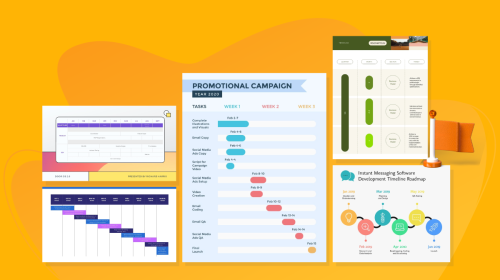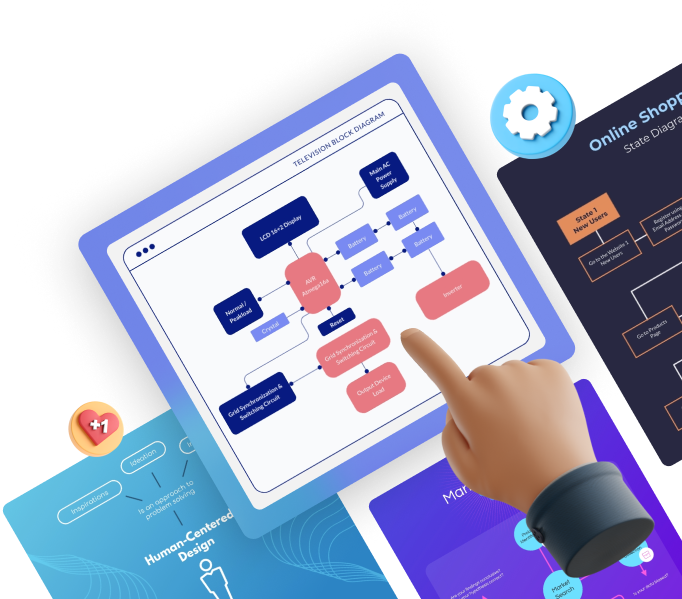
How to Use a Fishbone Diagram: 9 Cause and Effect Templates


A fishbone diagram is undoubtedly one of the best tools to find and visualize the root cause of any problem. But, how do you use it? Though it's an incredibly useful diagram, you might find it challenging to use due to its complex structure.
Go through the article carefully to get the most out of a fishbone diagram.
Here’s a short selection of 8 easy-to-edit fishbone diagram templates you can edit, share and download with Visme. View more templates below:
A fishbone diagram, also known as cause and effect diagrams, Ishikawa diagram and Herringbone diagram, is a visualization tool used to find the root cause of a problem.
It helps you group all the potential causes of a problem in a structured way to find the ultimate cause of your problem. Kaoru Ishikawa invented this diagram in the 1960s to use as a quality control tool at the University of Tokyo.
Today, the diagram has become much more versatile than just quality control. Here are some of the use cases of a fishbone diagram:
To leverage this amazing tool, you need to understand each of its components first. As the name suggests, the fishbone diagram is the side view of a fish skeleton.
A fishbone diagram always includes:
Many types of fishbone diagrams are available, but no single diagram can apply to every situation. Choosing the right type of fishbone diagram is always the key. Here are the four most popular fishbone diagrams that you can use:
The simple or classic fishbone diagram is one of the most basic and popular diagrams with no predetermined affinities or categories. You can create the affinities according to your organization or industry.
That means, instead of starting with preset categories we will discuss below, you can start by thinking of your own.
This fishbone diagram lets you categorize information about potential causes into four common categories:
Though any industry can use this diagram, the service industry can get the most out of it.
The 8P Fishbone Diagram is a visual way to consider your business in terms of the activities, products and processes that support it. The diagram examines and breaks down the interdependencies between these three things.
The diagram derived its name from the eight categories; it begins with "P."
The 8Ps are:
The 6M fishbone diagram is a visual way to organize and evaluate information about a project. It’s used for projects that are not yet finished but are still in the planning phase.
If you've been around the construction site, you probably know about this fishbone diagram. This is typically used when a team has to break tasks down into smaller parts identified by the 6M fishbone diagram.
The 6Ms are:
Sometimes you can add two additional categories, management and maintenance to fit your needs.
We will now give you a step-by-step guide to learning how to use a fishbone diagram.
The first step in problem-solving is always identifying the problem, whether you use a fishbone diagram or not. Your problem statement will give you an objective metric that will determine the rest of the process.
For example, creating a fishbone diagram to identify the root cause of failed SEO strategy will not be the same for a website crash.
Once you identify the problem, write it inside the "head" of the fishbone. It will look like the fishbone's head and spine, giving you space to develop ideas.
Transform technical, complex information into easy-to-understand reports

The diagram is designed to help you think about the potential causes in several categories represented by the bones. The number of categories depends on the complexity and type of the problem.
Deciding on the categories is important because it will help you choose the right type of fishbone diagram. For example, if you are in the service industry, you might need the 4S fishbone diagram. It includes:
Now that you have defined the categories, it's time to go through each of them. It will help you determine the most important causes of the problem.
For each of the categories you considered in step 2, brainstorm all the potential causes that may be related to the factor. If a source cause supersedes a potential cause, you can remove it from the diagram.
You can use Visme’s mind map maker to make your brainstorming process more effective.
By now, your fishbone diagram should be ready, showing all the possible causes of the problem. Investigate the most common ones further according to the complexity and importance of the problem.
You can carry out surveys, set up investigations and many more. These will ultimately help you identify the root cause contributing to the problem.
The fishbone diagram will not direct you to the solution. But, once you find the root cause, you will understand where to look for. Once you get the root cause, determine your next steps to find the solution and prepare for future problems. It's also important to note that a good diagram maker helps to make this final step easier to illustrate.
Below are a few templates that you can use to create your fishbone diagram. We will also share some design tips along the way to help you customize these templates easily in Visme.
Global warming is undoubtedly one of the significant problems on our planet that is happening due to a lot of factors. A fishbone diagram is a perfect way to visualize the causes of a complex problem like this.
This template shows all the potential causes of global warming. Non-profit organizations, educational institutions and other organizations fighting for this cause can use this template. It will help them educate people and spread awareness.
Website crash is one of the most frustrating incidents you may experience. You need to rush through it to make sure that the website goes live again in no time.
This fishbone diagram displays all the aspects that could cause a website crash. It is designed to monitor all the issues such as traffic overload, broken code, hacking and many more.
Edit this template in Visme and collaborate with all your team members in real-time to fix the issue ASAP! Collaborators can pin, circle and draw any part of the diagram. Also, they can review, respond and resolve comments as needed.
Check out Visme's collaborative features or watch the video below to learn more.
Is your digital marketing strategy not getting enough leads for your business? It might be due to poor link building, mobile unfriendly website, improper use of data and many other reasons. This fishbone diagram includes all the potential causes that may cause a digital marketing strategy failure.
As a digital marketer, you must always be ready to change with the times. Edit this template according to your strategy and find the root cause of the problem.
One of the greatest advantages of digital marketing is that you can use analytics to measure the results. With Visme's analytics feature, you can track traffic and gauge the effectiveness of each of your projects.

Is your website losing traffic, or are your rankings plummeting? It might be a technical issue, a website change, a Google algorithm update or poor SEO.
Based on the 4S method, this fishbone diagram can help you find the ultimate cause. It comes with a two-tone color combination and icons to make your brainstorming sessions fun and effective.
Visme comes with 10,000+ icons in 20+ categories across four distinct styles to complement any design need. Also, you can add motion to your fishbone diagram with animated icons.
As we have already discussed, a fishbone diagram allows you to address complex problems. Detecting surface flaws is one of them. Surface flaw detection usually includes materials, man, machines, measurements, mother nature and methods. In that case, you will need this 6M fishbone diagram to find the root cause.
Overproduction is the worst of the seven wastes of lean manufacturing that you must try to stop immediately. It causes you to tie up your capital, work in progress, raw materials and finished goods.
This fishbone diagram template is designed to determine the causes of overproduction waste in the rubber industry. However, you can use it according to your needs, especially in the manufacturing industry.
Visme’s drag-and-drop editor will allow you to customize every aspect of the fishbone diagram template. You can make the shapes larger or smaller without losing connection to the lines. Or choose from a variety of line styles and endpoints.
Customer satisfaction is one of the major factors that you must consider as a business to compete in the market. According to a recent survey, 76% of customers say they would do business with a competitor after more than one bad experience.
Use this customer satisfaction fishbone diagram to understand why your business is unable to provide excellent customer service.

Google regularly updates its search engine optimization algorithm. If you are not updating your SEO strategies, it might lead to a slower conversion rate.
From keyword research and link building to technical SEO and mobile experience, this fishbone diagram shows almost all the causes that may lead to SEO strategy failure.
Tech fishbone diagrams don’t need to be complex. Sometimes, simplicity is the key. This fishbone diagram template with colorful icons is perfect for making any complex technical issue simpler.
Open this template in the Visme editor, customize the text and change the icons to match your needs. To add more visual emphasis, use animated icons, illustrations and other special effects. Also, you can animate sections of your fishbone by adding animated enter and exit effects and more.
Visme offers various other types of flowcharts that you can use to design the planning process. Choose a flowchart template from the extensive library and customize them to fit your needs.

Congratulations! You have successfully learned how to get the most out of a fishbone diagram. Choose any of the templates above and customize it using Visme's free online flowchart maker and you are all set.
Sign-up today to start creating your fishbone diagram in Visme.
Design visual brand experiences for your business whether you are a seasoned designer or a total novice.
Try Visme for free